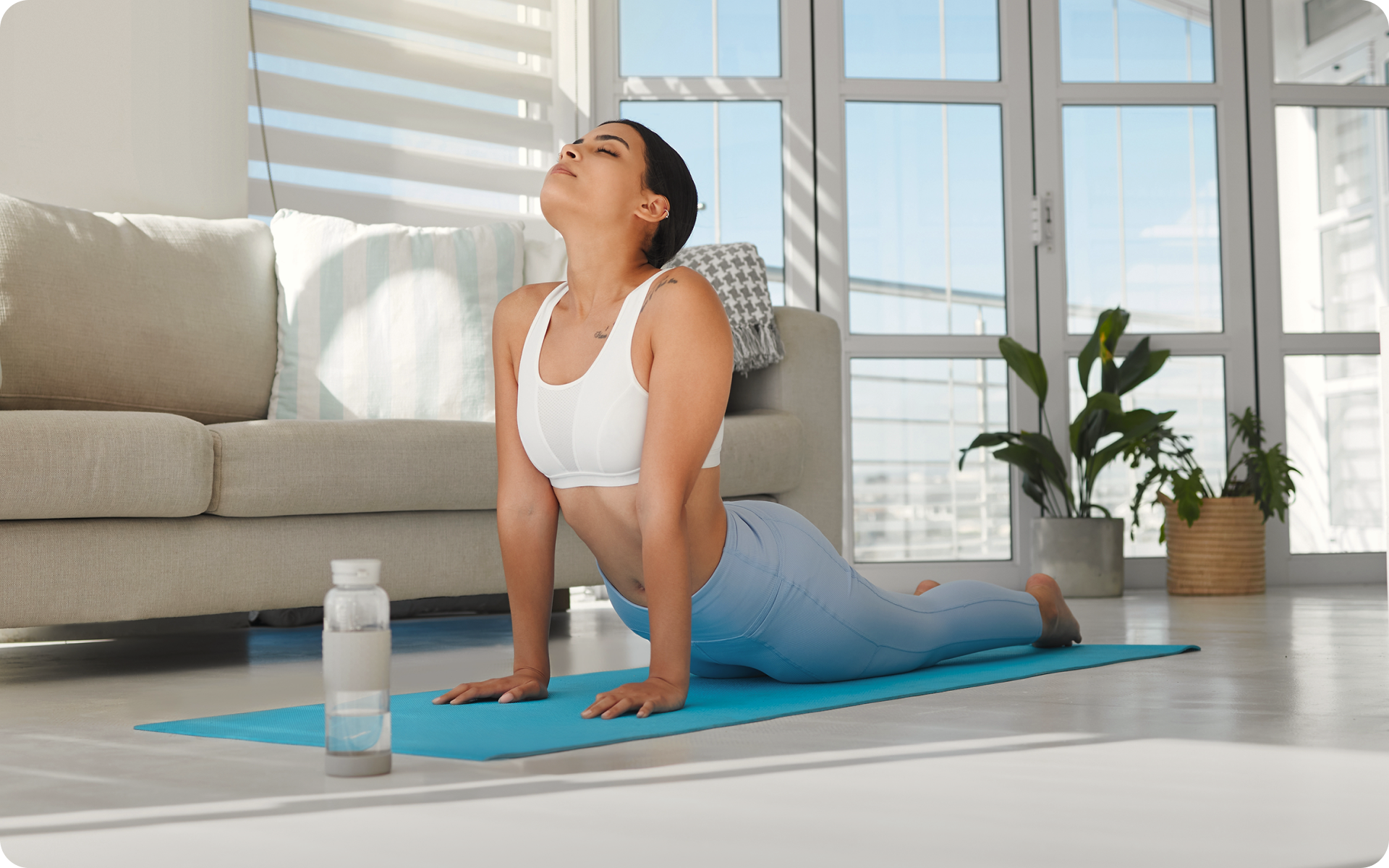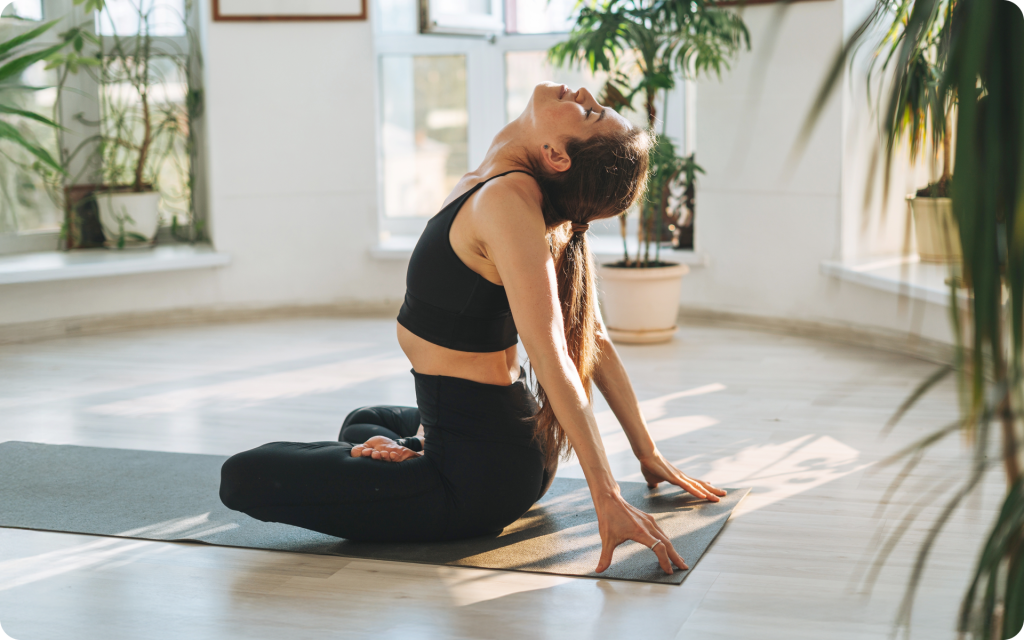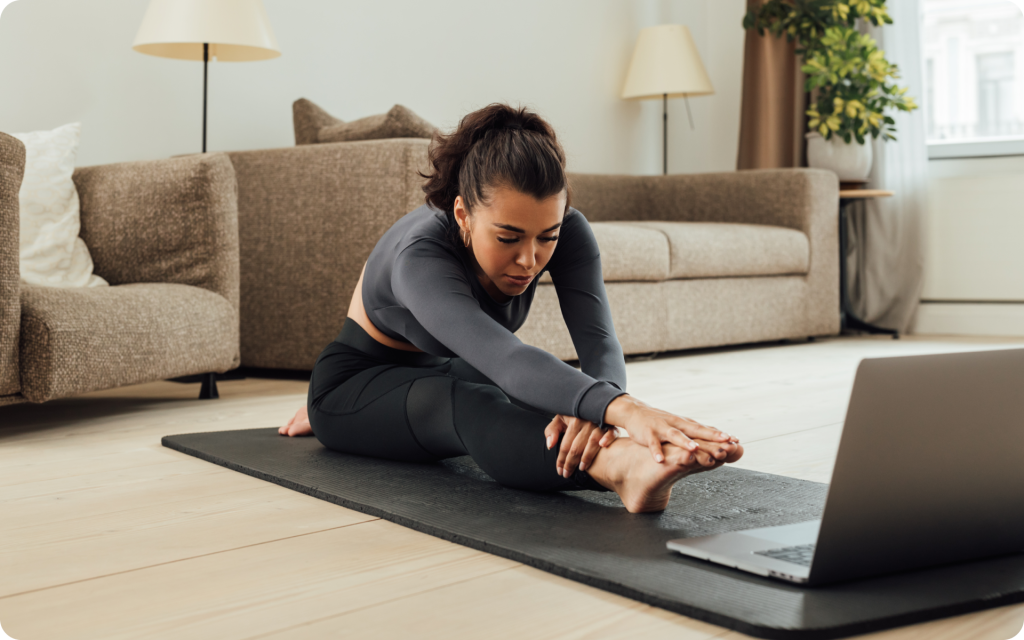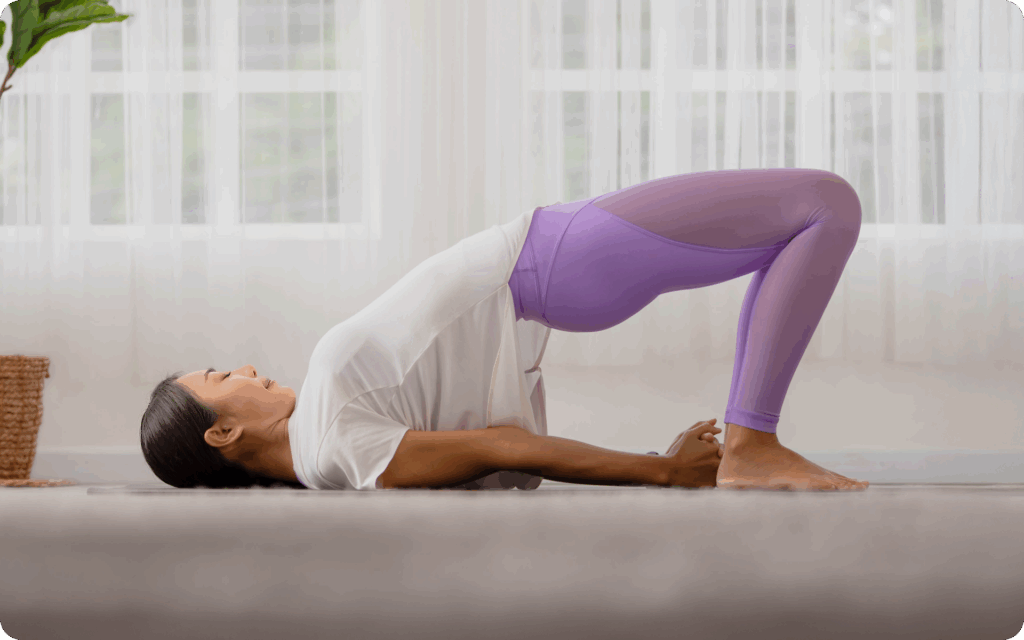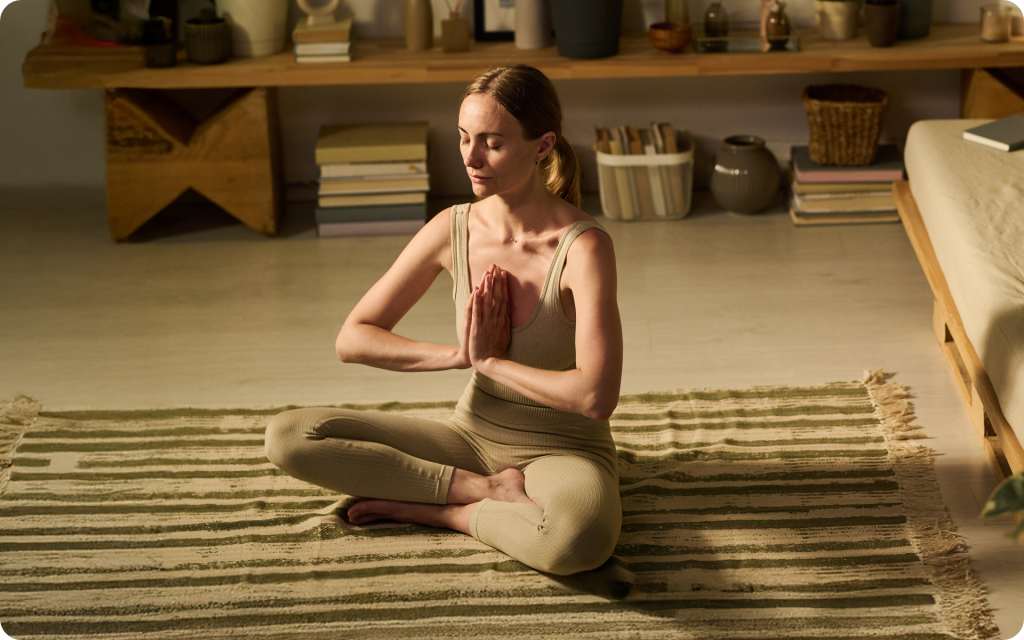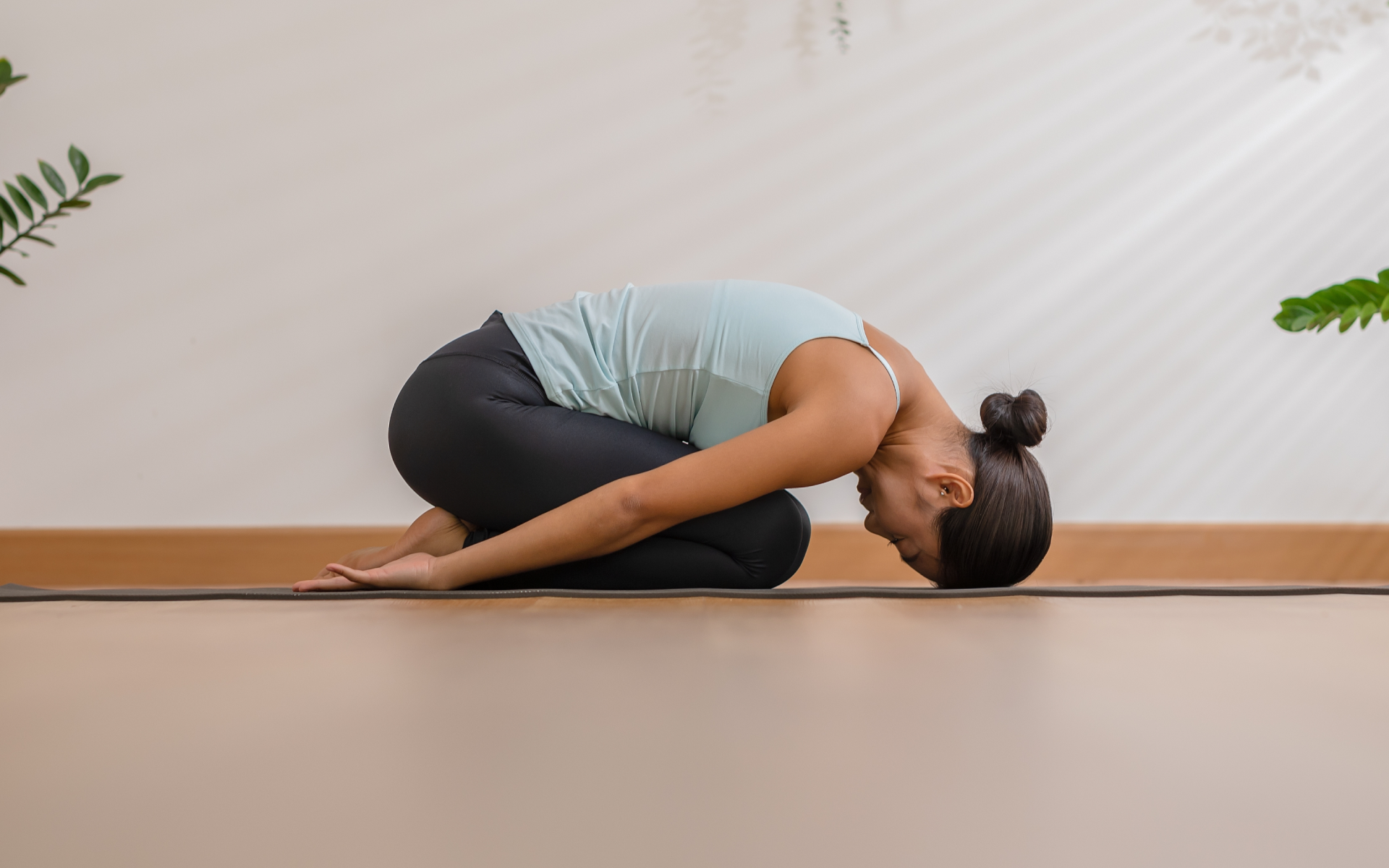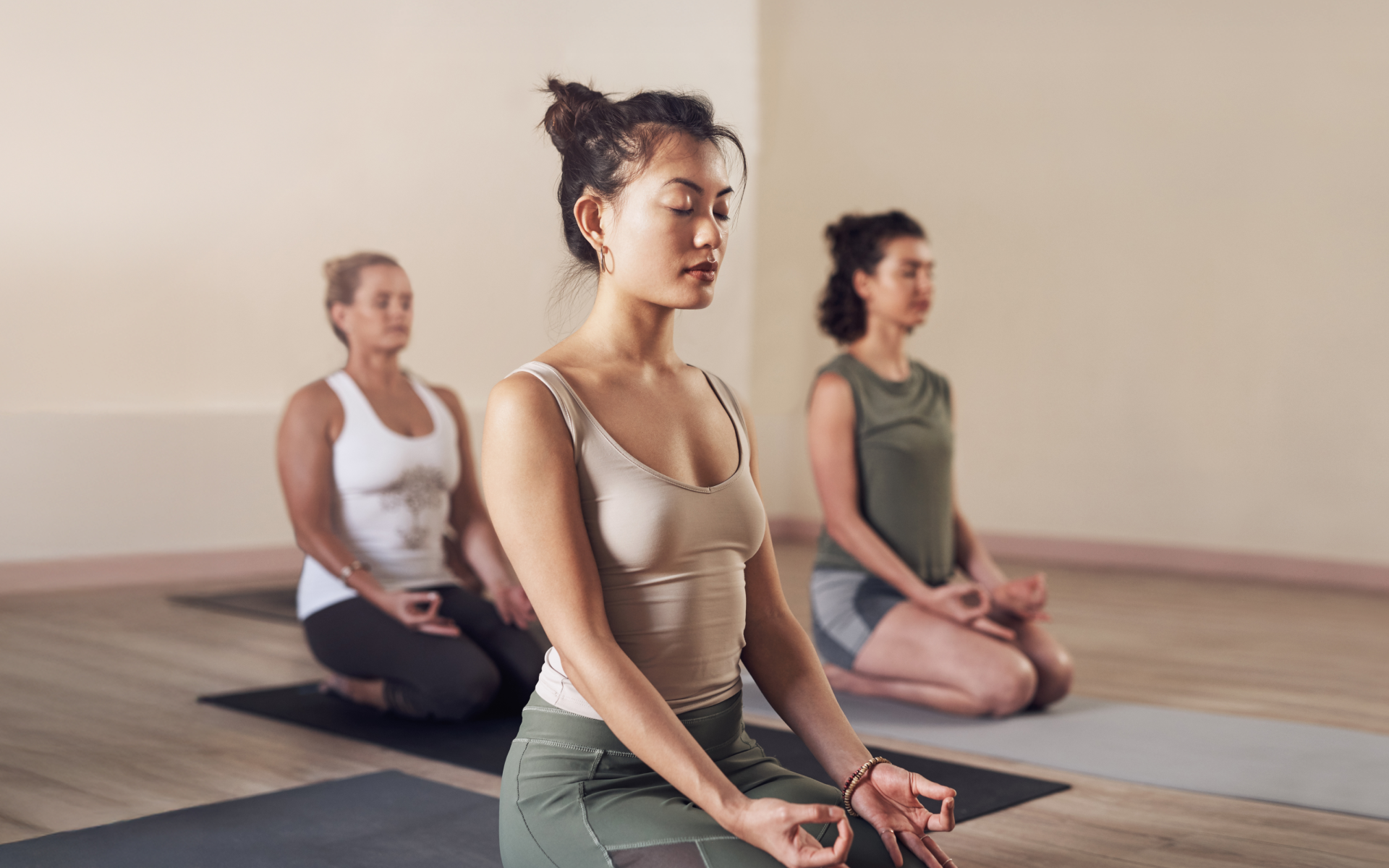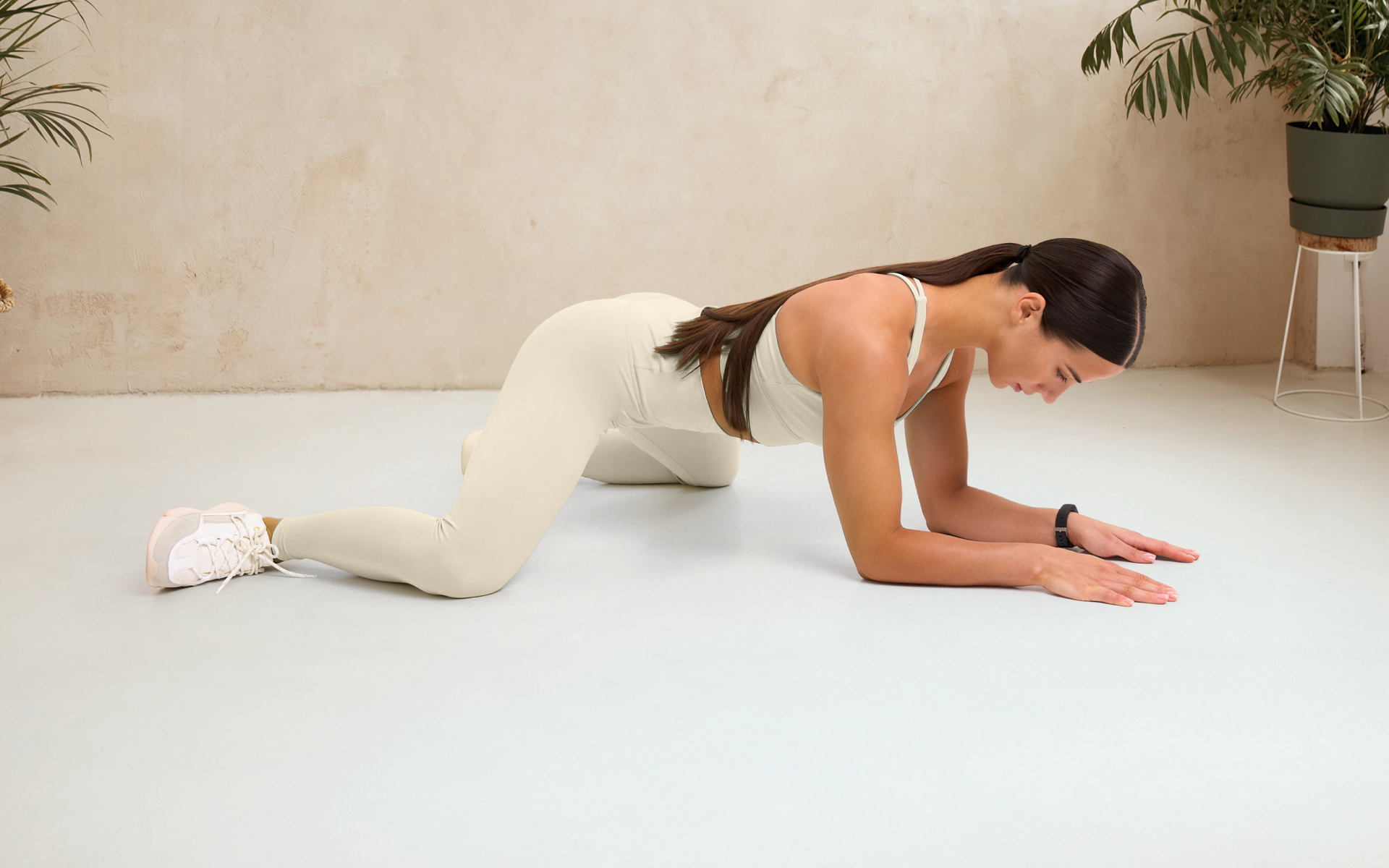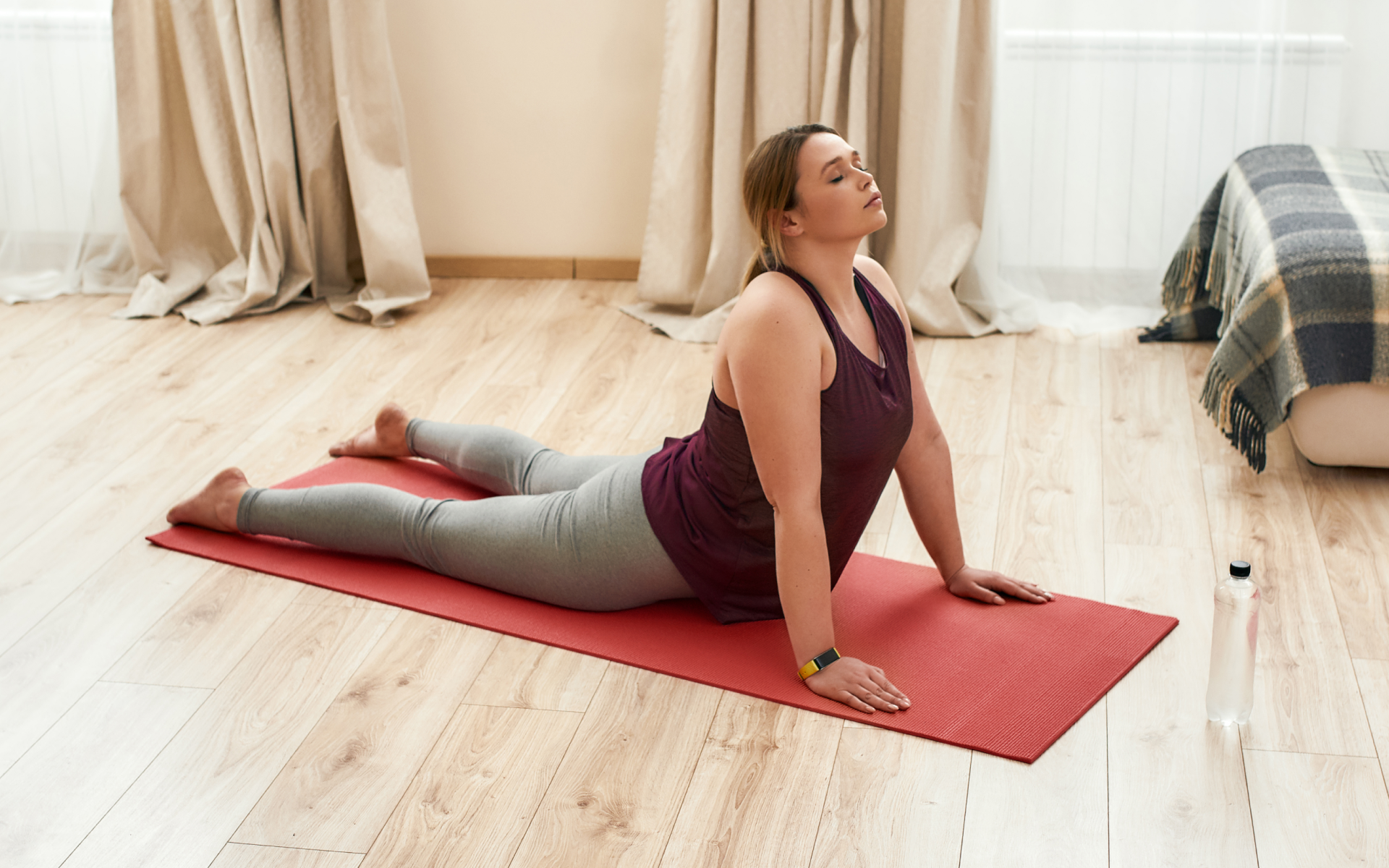The idea of a strong mind-body connection dates back thousands of years, but it’s now gaining renewed attention as a simple but potentially powerful way of supporting well-being (1).
Somatic yoga focuses on supporting the mind-body connection by shifting the focus inward. Unlike traditional yoga, which often emphasizes flexibility or precise postures, a somatic yoga routine uses slow, mindful movement with the goal of heightening self-awareness, releasing built-up tension, and restoring balance between the mind and body (2).
This guide will explore what somatic yoga is, how it works, the unique benefits it may offer to different groups, and a flowing somatic yoga routine you can try at home.
What Is Somatic Yoga?
Somatic yoga combines the principles of somatic movement with traditional yoga practices, with movements usually being very slow, mindful, and gentle on the body (3). The goal isn’t to achieve “perfect” poses or stretch as far as you can, but to build mindful awareness of how your body feels and responds during movement (4).
More specifically, somatic yoga utilizes three types of body awareness (5):
- Interoceptive: Noticing internal sensations and bodily cues such as breathing patterns, heart rate, and muscle tension
- Exteroceptive: Noticing your surroundings through external stimuli such as touch, sound, and changes in temperature
- Proprioceptive: Sensing your body’s movement and overall position in space
In addition, many somatic yoga routines incorporate aspects of deep breathing, grounding, and other coping strategies to support relaxation and self-regulation (6). This helps make somatic yoga accessible to a wide range of people, which allows you to adapt your routine to fit your needs, goals, and physical ability.
That being said, if you’re dealing with any medical conditions or mental health concerns, it’s best to consult your healthcare provider before you start any new mind-body practice to make sure it’s appropriate for your health needs and goals.
Reasons why BetterMe is a safe bet: a wide range of calorie-blasting workouts, finger-licking recipes, 24/7 support, challenges that’ll keep you on your best game, and that just scratches the surface! Start using our app and watch the magic happen.
What Is an Example of Somatic Yoga?
There are plenty of somatic yoga exercises to explore, many of which can be found on the BetterMe app, but a simple example is the “arch and flatten” exercise (7):
- Lie on your back with your knees bent and your feet on the floor, hip-width apart.
- Gently arch your lower back while inhaling deeply through your nose.
- Take a moment to notice any internal sensations that arise during this pose.
- Slowly flatten your back into the mat as you exhale slowly.
- Repeat this process, moving at your own pace and with mindful awareness of what your body is telling you.
The purpose of this exercise isn’t to stretch as far as possible but to gently release any stored tension while tuning into your body’s signals. Over time, this mindful approach can help strengthen the connection between the mind and body, which is a principle at the core of almost every somatic practice (8).
Read more: Is Yin Yoga Somatic Exercise? Everything You Need to Know
Does Somatic Yoga Actually Work?
While many people are aware of the physical benefits of yoga, not everyone realizes just how powerful it can also be for emotional and mental well-being (9). Even with the rise of mind-body practices, many people still wonder if somatic yoga really works.
With the right environment and techniques, somatic yoga can work, but in different ways than traditional exercise. Instead of pushing for intensity or quick results, it focuses on slow, mindful movements that help you tune into your body, release tension, and promote mind-body balance (2).
However, it should never be a replacement for professional treatment, particularly when you’re dealing with medical conditions or mental health concerns. Pairing somatic yoga with the guidance of a qualified healthcare provider is the best way to make sure it supports your needs safely and effectively.
What Are Some Somatic Yoga Benefits?
The effects of somatic yoga can vary widely from person to person and so can the time it takes to notice them. Some people may feel relief immediately, while others may need more time to notice any meaningful benefits.
Some benefits you may notice from practicing somatic yoga include:
- Increased mindfulness (10)
- A greater sense of relaxation (10)
- Better self-regulation of emotions (10)
- Improved mind-body awareness (11)
- Reduced feelings of stress and worry (11)
- Reduced chronic pain and muscle tension (11)
- Improved flexibility, balance, and physical mobility (12)
Somatic Yoga Routines for Different Needs
One of the best things about somatic yoga is how adaptable it is, which makes it accessible for people with different goals, abilities, or health needs.
While the core principles stay the same (slow, mindful movement and tuning into body sensations), the way you approach your routine can look a little different depending on your personal needs and goals. Here are a few of the ways that somatic yoga can be tailored to different circumstances.
What Is a Somatic Yoga Routine for Beginners?
A somatic yoga routine for beginners often involves trying out different poses, learning how to tune into your body without judgment, and creating a practice that feels right for you moving forward. Remember, the goal isn’t to get certain poses “right” but to notice how your body moves and feels in each moment.
When you first start, your routine may only last 5 to 10 minutes, and that’s perfectly fine. It’s best to start slow and gradually add more movements or lengthen your sessions as it feels natural, without pushing yourself too hard.
Some good starting somatic yoga exercises for beginners include:
- Shoulder rolls: Ideal for relieving upper-body tightness, which can be practiced seated or standing up (13).
- Constructive rest pose: Lying on your back with your knees bent to encourage body awareness and relaxation (14).
- Cat-cow stretches: Flows between arching and rounding your spine to release tension and improve spinal mobility (15).
When it comes to weight loss, progress is made by inches, not miles, so it’s much harder to track and a lot easier to give up. The BetterMe: Health Coaching app is your personal trainer, nutritionist, and support system all in one. Start using our app to stay on track and hold yourself accountable!
Is Somatic Yoga for Older Adults?
Yes, a somatic yoga routine for seniors can be particularly helpful for improving mobility, balance, and overall quality of life (12). As the movements are slow and low-impact, older adults can safely practice from a chair or on the floor with modifications (always with the approval of a healthcare provider).
Even if certain poses don’t seem like they’ll work for you, most of them can be adapted to suit your needs, whether that means adding a chair, standing by a wall, or using other props for support, comfort, and safety. However, if a specific pose feels too overwhelming or uncomfortable, it’s best to skip it and choose an easier, more accessible option.
Some helpful somatic yoga exercises for older adults can include:
- Tree pose: A standing pose that is known for improving balance and stability, standing by a wall in case you lose balance (16).
- Chair yoga: Simple seated variations of poses, such as forward folds or pelvic tilts, to promote safety while still enjoying the benefits of somatic movement (17).
Can Somatic Yoga Help with Trauma?
Somatic yoga for trauma may be a supportive tool for reconnecting with your body and regulating emotions in a safe, gradual way (18), as long as you’re being guided by a qualified professional and with the approval of your healthcare provider. Trauma release yoga is a more focused, intense form that is designed to help with the healing process, so it’s important to work with a qualified, trauma-trained provider when you engage in this work.
Many somatic yoga poses can be adapted to support trauma recovery, under the supervision of a trauma-trained provider, and they often incorporate the following key techniques:
- Gentle movement: Slow movements that encourage awareness and the release of tension without overwhelming the body (19).
- Grounding: Using your sensations to help you feel rooted and present in your body and the current moment (20).
- Breathwork: Slow, intentional breathing to regulate the nervous system (21).
- Self-compassion: Learning to listen to your body without judgment or criticism, but with curiosity and compassion (22).
Can I Lose Weight with Somatic Yoga?
Somatic yoga isn’t about burning calories quickly or achieving physical fitness goals, as it focuses heavily on slow, mindful movement and your internal experience (2).
However, it can support weight management by contributing to healthier lifestyle habits. Research has suggested that mind-body practices, such as somatic yoga, may promote stress relief, better self-awareness, and healthier coping strategies, all of which may indirectly help with losing weight (23).
Combining a regular somatic yoga practice with balanced eating, proper hydration, and other healthy habits can be an effective way to support your long-term health goals (24). However, if your main focus is weight loss, it’s always best to consult your healthcare provider to get more personalized guidance and recommendations.
Read more: How To Practice Somatic Chair Yoga At Home As A Beginner
Flowing Somatic Yoga Routine
One of the best things about somatic yoga is how accessible it can be. Practicing a somatic yoga routine at home can be easier than you might think – all you need is a comfortable space to move with no interruptions. A yoga mat, yoga block, chair, or other props can also be helpful, depending on your needs and comfort level.
To get you started, here’s a beginner-friendly somatic yoga routine that only takes approximately 5 to 10 minutes (but you can repeat, slow down, or expand each step to suit your needs and comfort level).
Step 1: Center and Breathe
- Sit or lie down in a comfortable position and close your eyes if you want to.
- Take slow, steady breaths in through your nose and out through your mouth.
- Notice how your chest, belly, and ribs rise and fall as you breathe deeply.
Tip: Focus on simply observing your natural patterns of breathing and not trying to change anything.
Step 2: Pelvic Tilts (Arch and Flatten)
- Lie on your back with your knees bent and your feet flat on the floor, hip-width apart.
- Inhale slowly and gently arch your lower back, creating a small space between your back and the floor.
- Pause briefly in this position and notice any internal sensations that arise.
- Exhale slowly as you gently press your lower back into the floor.
- Repeat this process around 5 times, paying attention to how your body feels.
Tip: Try allowing your breath to guide each movement, arching as you inhale and tilting back down with each exhale.
Step 3: Cat-Cow Flow
- Come onto your hands and knees with your wrists under your shoulders and your knees under your hips.
- Inhale slowly as you arch your back, lifting your chest and tailbone (cow pose).
- Take a moment to notice any sensations in your body in this position.
- Exhale as you round your back, tucking your chin and tailbone inward (cat pose).
- Continue these for 5 to 6 cycles, matching your breath with each movement.
Tip: Don’t rush through the motions and let your body move at its own pace.
Step 4: Gentle Twist
- Sit cross-legged or with your legs stretched forward.
- Place your right hand on your left knee and your left hand behind you for support.
- Slowly inhale, then exhale while gently twisting your body to the left.
- Hold this for 2 to 3 breaths while noticing any sensations that arise.
- When ready, slowly return to the center and repeat on the other side.
Tip: Instead of focusing on how far you can twist, pay attention to how the twist feels in your ribs and spine during each breath.
Step 5: Closing Rest
- Lie on your back with your knees bent and your arms resting comfortably by your sides.
- Close your eyes and allow your breath to settle into a natural rhythm.
- Gently scan your body from head to toe, noticing any areas of tension or any other sensations without judgment.
- With each exhale, let those areas soften and release, giving yourself permission to simply “be” rather than “do”.
For more ideas on modifications or additional exercises you can include in your somatic yoga routine, you can explore resources such as the BetterMe app, which offers guided options to help you adapt the practice to your needs.
How Long Does Somatic Yoga Take to Work?
The timeline for seeing results from somatic yoga varies from person to person. Some people may notice an immediate sense of relaxation or tension release after one session, while others may need more regular practice to feel deeper changes.
The best approach is to start slow and gradually build up until you find a routine that feels right for your body and lifestyle. Some days you may only have a few minutes, and that’s okay – what matters most is that you show up consistently.
While there’s no set timeline, consistently practicing at a pace that feels natural may lead to meaningful benefits over time.
Somatic yoga isn’t necessarily “better” than traditional yoga, it just has a different focus. While traditional yoga often focuses on strength, flexibility, or other physical outcomes, somatic yoga emphasizes slow, mindful movement and body awareness (2). Both can have their own set of benefits, so the better choice will simply depend on your goals. While many somatic exercises can be practiced alone, somatic therapy sessions involve deeper emotional work and should be guided by a trained professional. Having this professional guidance helps ensure your safety and provides support in navigating any challenging sensations, emotions, or memories that arise. Somatic yoga may help reduce stress, which may lower your cortisol levels over time (25). By slowing down, focusing on breath, and tuning into your body’s sensations, somatic yoga can activate the body’s relaxation response, helping calm the nervous system and promote a sense of relaxation. There’s no set rule or schedule regarding how often you should practice somatic yoga, as it all depends on your needs and goals. Start with what feels manageable, whether it’s just a few minutes per day or a couple of sessions per week, and gradually build a routine that works for you.Frequently Asked Questions
Is somatic yoga better than yoga?
Can I do somatic therapy on myself?
Does somatic yoga reduce cortisol?
How many times a week should you do somatic yoga?
The Bottom Line
A somatic yoga routine can be a powerful way to reconnect with your body and support overall well-being. By slowing down and staying present in the moment, you can build greater awareness of how your body moves, feels, and responds to everyday situations.
Even a few minutes a day can make a meaningful difference to your physical, mental, and emotional well-being. Just make sure you get approval from your healthcare provider before you start, particularly when dealing with medical or mental health concerns.
For more resources, tutorials, and wellness tips to support your well-being, check out the BetterMe app – your companion to a healthier, happier you.
DISCLAIMER:
This article is intended for general informational purposes only and does not serve to address individual circumstances. It is not a substitute for professional advice or help and should not be relied on for making any kind of decision-making. Any action taken as a direct or indirect result of the information in this article is entirely at your own risk and is your sole responsibility.
BetterMe, its content staff, and its medical advisors accept no responsibility for inaccuracies, errors, misstatements, inconsistencies, or omissions and specifically disclaim any liability, loss or risk, personal, professional or otherwise, which may be incurred as a consequence, directly or indirectly, of the use and/or application of any content.
You should always seek the advice of your physician or other qualified health provider with any questions you may have regarding a medical condition or your specific situation. Never disregard professional medical advice or delay seeking it because of BetterMe content. If you suspect or think you may have a medical emergency, call your doctor.
SOURCES:
- Editorial: Moving the mind, thinking the body: new insights on the mind-body connection from the neuroscience of movement, sports, arts, yoga, and meditation (2024, nih.gov)
- Yoga as a Mind-Body Practice (2020, link.springer.com)
- Combining Your Clinical Somatics and Yoga Practices (2019, somaticmovementcenter.com)
- Mindfulness-Based Interventions and Body Awareness (2022, nih.gov)
- An Overview of the Bodily Awareness Representation and Interoception: Insights and Progress in the Field of Neurorehabilitation Research (2024, nih.gov)
- Reducing Stress with Yoga: A Systematic Review Based on Multimodal Biosignals (2024, nih.gov)
- Arch & Flatten (2019, somaticmovementcenter.com)
- A Brief Intro to the World of Somatics (2020, healthline.com)
- Attitudes, knowledge and understanding towards mind-body practices as an asset for social prescribing in higher education (2023, tandfonline.com)
- Reducing Stress with Yoga: A Systematic Review Based on Multimodal Biosignals (2024, nih.gov)
- Exploring the therapeutic effects of yoga and its ability to increase quality of life (2011, nih.gov)
- Impact of Somatic Yoga and Meditation on Fall Risk, Function, and Quality of Life for Chemotherapy-Induced Peripheral Neuropathy Syndrome in Cancer Survivors (2019, nih.gov)
- Shoulder roll (seated) (2024, northshore.org)
- Alexander Technique Constructive Rest (n.d., alexandertechnique.com)
- Cat/cow pose (2023, mayoclinic.org)
- The Physical Demands of the Tree (Vriksasana) and One-Leg Balance (Utthita Hasta Padangusthasana) Poses Performed by Seniors: A Biomechanical Examination (2012, nih.gov)
- Effect of Chair Yoga Therapy on Functional Fitness and Daily Life Activities among Older Female Adults with Knee Osteoarthritis in Taiwan: A Quasi-Experimental Study (2023, nih.gov)
- A Rapid Review Exploring the Role of Yoga in Healing Psychological Trauma (2022, nih.gov)
- Somatic experiencing: using interoception and proprioception as core elements of trauma therapy (2015, frontiersin.org)
- Exhibit 1.4-1: Grounding Techniques (2014, nih.gov)
- The integration of yoga breathing techniques in cognitive behavioral therapy for post-traumatic stress disorder: A pragmatic randomized controlled trial (2023, nih.gov)
- The protective role of self compassion in trauma recovery and its moderating impact on post traumatic symptoms and post traumatic growth (2025, nih.gov)
- Mind-Body Solutions for Obesity (2010, nih.gov)
- Role of Physical Activity for Weight Loss and Weight Maintenance (2017, nih.gov)
- Reduce stress and the risk of burnout by using yoga techniques. Pilot study (2024, nih.gov)
